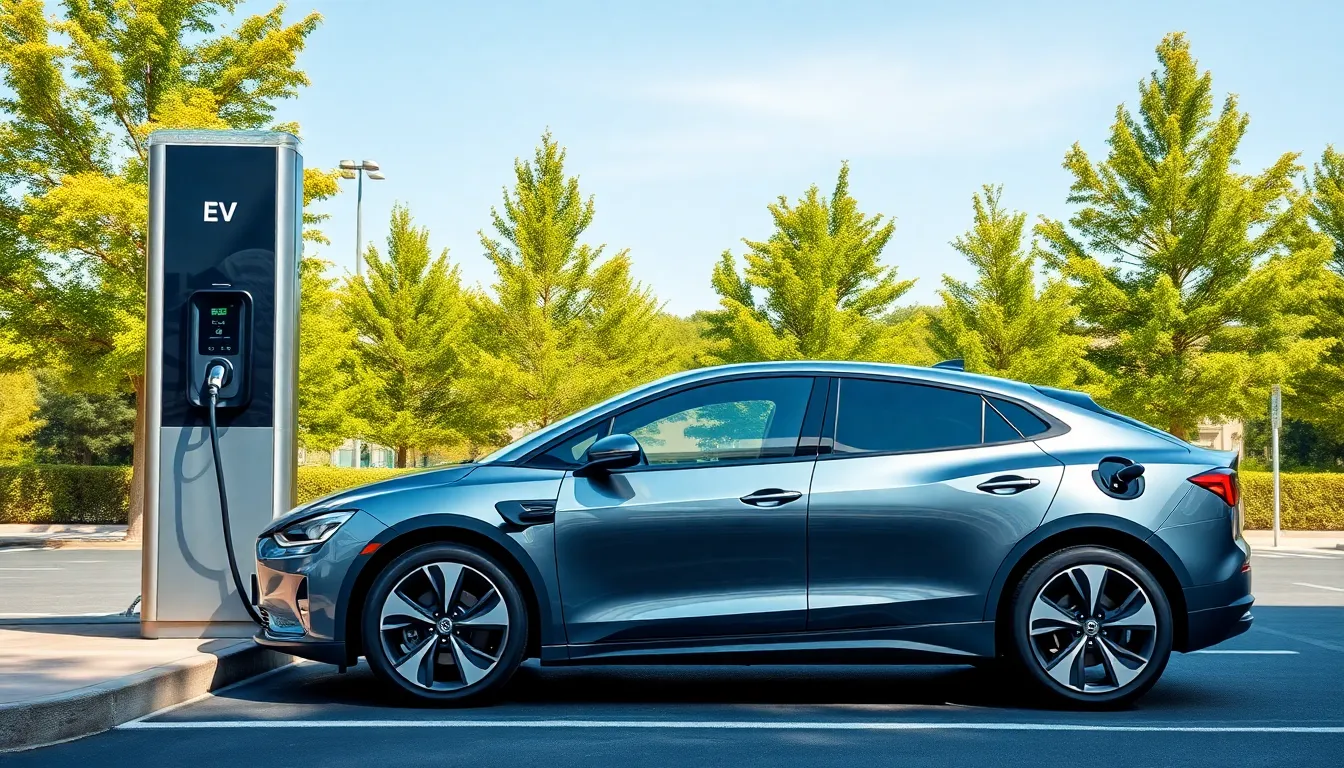The electric vehicle (EV) market is experiencing a remarkable surge, transforming the automotive landscape as we know it. With growing environmental concerns and advancements in technology, consumers are increasingly opting for cleaner, more sustainable transportation options. This shift not only reflects a change in consumer preferences but also highlights the commitment of manufacturers to innovate and adapt.
As governments worldwide implement stricter emissions regulations and offer enticing incentives, the momentum behind EV adoption continues to build. Major automakers are investing heavily in electric models, while startups are emerging with fresh ideas and solutions. This dynamic growth is reshaping the future of mobility, making it essential to understand the factors driving this revolution and what it means for consumers, businesses, and the planet.
Table of Contents
ToggleOverview of EV Market Growth
The electric vehicle (EV) market continues to expand rapidly, fueled by heightened environmental awareness and technological progress. In 2022, global EV sales reached approximately 10 million units, reflecting a growth rate of over 55% from the previous year. Consumers increasingly favor sustainable transportation options, leading to a marked shift in market dynamics.
Key factors driving this growth include stringent emissions regulations and strong government incentives. For instance, in the United States, federal tax credits of up to $7,500 encourage EV purchases, while several states offer additional benefits. Major automakers, such as Tesla, Volkswagen, and Ford, invest heavily in electric vehicle technology, with plans to produce a combined total of over 30 million EVs by 2030. This commitment accelerates innovation and increases the availability of diverse models.
Technological advancements in battery performance, charging infrastructure, and autonomous driving play crucial roles in shaping the market. The average range of EV batteries improved to about 250 miles in 2022, alleviating consumer concerns about range anxiety. Additionally, the expansion of public charging networks worldwide enhances accessibility, further promoting EV adoption.
Market forecasts suggest continued growth, with estimates indicating that EVs could account for up to 30% of global vehicle sales by 2030. This transformation in the automotive landscape not only benefits consumers but also contributes to reduced greenhouse gas emissions, aligning with global sustainability goals.
Key Drivers of EV Market Growth

Key drivers behind the electric vehicle (EV) market growth include proactive government policies and significant technological advancements. These factors create a favorable environment for both consumers and manufacturers, accelerating the shift towards electric mobility.
Government Policies and Incentives
Government policies play a vital role in promoting EV adoption. Many countries offer incentives such as federal tax credits, rebates, and grants to encourage consumers to purchase EVs. In the U.S., federal tax credits can provide up to $7,500 per vehicle. Additionally, several states offer their own incentives, which can further lower purchase prices. Stricter emissions regulations also compel manufacturers to invest in electric technologies, aligning business goals with environmental responsibilities. The European Union aims for a significant reduction in greenhouse gas emissions by 2030, which motivates countries to implement supportive policies. Infrastructure investments, such as federal funding for charging stations, enhance accessibility and convenience for EV owners, fostering a more robust market.
Technological Advancements
Technological advancements significantly influence the EV market’s expansion. Improvements in battery technology, such as increased energy density and faster charging capabilities, help reduce costs and improve vehicle performance. The average EV battery range now exceeds 250 miles, which addresses consumer concerns about range anxiety. Moreover, innovations in software and hardware, including smart charging solutions and vehicle-to-grid technologies, enhance user experience and convenience. Automakers are also exploring alternative battery chemistries, such as solid-state batteries, which promise even greater efficiency and safety. These advancements boost consumer confidence and stimulate demand for electric vehicles.
Major Players in the EV Market
The EV market features a diverse array of competitors, including established automakers and emerging startups. Each group plays a crucial role in shaping the industry’s landscape.
Established Automakers
Established automakers significantly influence the EV market. Major companies like Tesla, Volkswagen, Ford, and General Motors drive innovation through substantial investments in electric vehicle technologies.
- Tesla leads in global market share, selling over 1 million EVs in 2022, focusing on long-range battery technology and autonomous driving features.
- Volkswagen aims to sell 1 million electric models annually by 2025, emphasizing affordable options with the ID.4 series.
- Ford plans to invest $50 billion in EV development by 2026, with vehicles like the Mustang Mach-E and the F-150 Lightning.
- General Motors targets a fully electric lineup by 2035, launching models like the Chevrolet Bolt and the Cadillac Lyriq.
These established players leverage their brand recognition, manufacturing expertise, and distribution networks, enhancing market penetration by expanding their EV offerings and supporting infrastructure.
Emerging Startups
Emerging startups contribute innovative solutions and fresh competition in the EV market. Companies such as Rivian, Lucid Motors, and NIO are gaining traction with unique offerings and tailored technologies.
- Rivian focuses on electric trucks and SUVs, with the R1T and R1S prioritizing adventure-ready features, having produced over 20,000 units by 2022.
- Lucid Motors specializes in luxury EVs, showcasing the Lucid Air, which offers over 500 miles of range and exceptional performance, appealing to high-end consumers.
- NIO, based in China, has carved out a niche with its battery swapping technology, providing users convenient options for battery replacement and enhancing convenience for city driving.
These startups inject creativity and agility into the market, often bringing cutting-edge technology and novel business models that challenge traditional automakers.
Challenges Facing EV Market Growth
The electric vehicle (EV) market faces several challenges that could impact its sustained growth. Addressing these obstacles is crucial to facilitate broader adoption and enhance market stability.
Infrastructure Development
Infrastructure development presents a significant challenge for EV market growth. Charging stations’ availability directly influences consumer adoption and confidence. Many regions lack sufficient charging networks, often making long-distance travel inconvenient for EV owners. Reportedly, as of 2023, less than 25% of U.S. cities possess adequate charging facilities to meet current EV demands. Public and private investments must focus on expanding infrastructure, ensuring accessibility across urban and rural areas. Moreover, the establishment of fast-charging stations will alleviate range anxiety, a common concern that hinders consumer enthusiasm for EVs.
Consumer Acceptance
Consumer acceptance of electric vehicles remains uneven, presenting another hurdle. Lack of awareness regarding EV benefits and misconceptions about performance contribute to hesitance among potential buyers. Many consumers view traditional internal combustion engine vehicles as more reliable, despite advancements in EV technology. According to surveys, over 40% of prospective buyers express concerns about charging times and battery life. Manufacturers must engage consumers through education and experiential marketing to promote understanding and alleviate fears. Additionally, addressing cost perceptions is vital, as many consumers still associate EVs with higher purchase prices, despite significant long-term savings on fuel and maintenance.
Future Trends in the EV Market
The electric vehicle (EV) market continues to evolve rapidly, with several trends shaping its future. Market projections and upcoming innovations indicate a robust landscape for electric mobility.
Market Projections
Market analysts predict significant growth in the EV sector over the next decade. Reports estimate that EV sales could reach approximately 30 million units annually by 2030, capturing nearly 30% of global vehicle sales. The increase results from escalating demand, environmental regulations, and enhanced vehicle offerings. In particular, the Asia-Pacific region leads in EV adoption, with China expected to dominate the market, supported by government initiatives. Europe and North America follow closely as established markets continue to buy into the EV revolution. Price parity with internal combustion engine (ICE) vehicles is anticipated by 2025, encouraging more consumers to switch to EVs.
Innovations on the Horizon
Innovations are pivotal in driving the future of the EV market. Breakthroughs in battery technology, such as solid-state batteries, promise greater energy density, shorter charging times, and improved safety features. Companies, including QuantumScape, explore this technology to revolutionize energy storage and address range anxiety concerns effectively. Additionally, advancements in autonomous driving technology are set to enhance the appeal of EVs, with established players and startups vying for leadership. Over-the-air software updates are also becoming mainstream, allowing manufacturers to improve vehicle performance and functionality post-purchase. Furthermore, the development of vehicle-to-grid (V2G) technology will allow EVs to serve as energy storage solutions, facilitating integration with renewable energy sources and contributing to grid stability.
The electric vehicle market is on a remarkable trajectory fueled by innovation and changing consumer preferences. As automakers ramp up production and governments enhance support through incentives, the shift toward sustainable transportation is gaining momentum. Challenges remain, particularly in infrastructure and consumer education, but the outlook is bright.
With projections indicating that EVs could represent a significant portion of global vehicle sales by 2030, the industry is poised for transformation. Continued advancements in technology and strategic investments will play a crucial role in overcoming barriers and driving widespread adoption. As the world moves toward a greener future, the EV market stands at the forefront of this evolution.






